Overview
This article serves as a compassionate guide, offering a detailed step-by-step approach to calculating A1C from glucose readings. Understanding how crucial this calculation is for effectively managing diabetes can be an empowering step in your health journey. The article explains the conversion formula clearly and provides practical methods, such as using online calculators and conversion charts, to make this process easier for you.
It's important to remember that regular A1C monitoring plays a significant role in your health management. By emphasizing this, we aim to support you in taking control of your health and improving your blood sugar management strategies. You're not alone in this journey; we are here to support you every step of the way.
As you read through, consider how these tools can fit into your daily routine and help you feel more confident in managing your diabetes. We encourage you to share your experiences and connect with others who understand what you're going through. Together, we can foster a supportive community that uplifts and encourages each other.
Introduction
In the realm of diabetes management, understanding A1C levels is essential for achieving optimal health outcomes. A1C, or hemoglobin A1C, is a key indicator of average blood sugar control over the past two to three months. This measure provides insights that can significantly influence your treatment decisions. For many navigating the complexities of diabetes, maintaining an A1C level below 7% is often a critical goal. However, it’s understandable that many struggle to reach this target.
As diabetes rates continue to rise, the importance of regular monitoring and effective management strategies cannot be overstated. This article delves into the intricacies of A1C testing, exploring its significance, methods for calculation, and practical tips for maintaining healthy levels. Our aim is to empower you to take charge of your diabetes care, reminding you that you’re not alone in this journey. We are here to support you every step of the way.
Understanding A1C: What It Measures and Why It Matters
A1C, or hemoglobin A1C, is an essential blood test that measures the percentage of hemoglobin in your blood that has bonded with glucose, a process known as glycation. This test reflects glucose measurements taken over the previous two to three months, serving as a vital gauge for effective blood sugar management. A lower A1C percentage signifies improved blood sugar control, which is crucial for minimizing the risk of complications associated with diabetes, such as cardiovascular disease and neuropathy.
At T2DSolutions, we understand the importance of keeping an A1C measure under 7% for individuals diagnosed with diabetes. However, personalized targets may be necessary, depending on individual health conditions and treatment goals. It's understandable to feel overwhelmed, especially when recent studies reveal that only around 50% of individuals with diabetes reach their target A1C levels, highlighting the ongoing challenges in managing this condition.
The total prevalence of diabetes from 2015-2018 was 12.7% (95% CI: 11.6–13.8), underscoring how widespread this condition is. The significance of the A1C test goes beyond mere numbers; it plays a pivotal role in guiding treatment decisions and assessing the effectiveness of management strategies. Unlike fasting plasma glucose (FPG) or oral glucose tolerance tests (OGTT), the A1C test is less susceptible to short-term fluctuations caused by factors such as diet, exercise, illness, or stress. This stability makes it a reliable indicator for understanding your blood sugar levels over the long term.
Clinical trials have shown that A1C readings can enhance the quality of life for individuals with chronic conditions, including blood sugar disorders. For example, a case study on interpreting A1C results classified ranges into normal, prediabetes, and elevated blood sugar, emphasizing the importance of performing the test in a certified laboratory for precise diagnosis. It's important to note that the A1C test is not suitable for diagnosing type 1 diabetes or gestational diabetes and may yield misleading results in certain medical situations.
At T2DSolutions, we are dedicated to providing resources and support for recently diagnosed patients to help you understand how to calculate A1C from glucose readings and develop effective control strategies. Expert opinions consistently affirm the critical role of A1C testing in managing blood sugar levels. As David F. Williamson, PhD, from the Hubert Department of Global Health at Emory University, notes, "A1C Measurement and Future Risk of Diabetes: A Systematic Review" highlights the importance of monitoring A1C measurements.
Specialists emphasize that regular monitoring can lead to timely interventions, ultimately reducing the risk of severe complications. Real-world examples show how maintaining optimal A1C standards can greatly influence health outcomes. Remember, you're not alone in this journey; we encourage you to actively participate in your care with the support of T2DSolutions.

The Connection Between A1C and Blood Glucose Levels
The A1C test serves as a crucial marker of average blood sugar levels, providing essential insights for managing health conditions. Understanding how to calculate A1C from glucose is important. The relationship is defined by the formula:
- Estimated Average Glucose (eAG) = (28.7 x A1C) - 46.7.
This means that for each percentage point increase in A1C, the average blood glucose concentration rises by about 28 to 30 mg/dL.
Recognizing this connection is vital. Tighter glucose control—keeping A1C values in the 7% range or lower—has been linked to a significant reduction in microvascular complications. Studies show a 35 to 76% decrease in these issues among individuals with type 1 diabetes. Landmark research, like the Diabetes Control and Complications Trial (DCCT), demonstrated that achieving lower A1C values not only reduces the risk of complications but also supports long-term cardiovascular health and mortality benefits. This highlights the importance of effective care for those managing high blood sugar.
Monitoring daily blood glucose readings can provide valuable insights into how to calculate A1C from glucose. This knowledge empowers individuals to make informed choices about their health care. By understanding how A1C levels relate to average blood glucose, patients can learn to calculate A1C from glucose, enhancing their understanding of treatment plans. This collaboration with healthcare professionals is key to achieving optimal health outcomes. Additionally, resources like flyers and PowerPoint presentations about using eAG in patient care are available to support individuals on their health journey.
As T2DSolutions opens as a new resource center for education, it aims to offer extensive support for individuals managing their condition. Vivian Fonseca emphasized in her editorial on the hemoglobin A1C assay that understanding these metrics is essential for effective diabetes care. By leveraging this knowledge, patients can enhance their management strategies and improve their overall health.
To stay informed about the latest resources and information, consider subscribing to T2D Solutions for email notifications when new content is published. Remember, you're not alone in this journey; we are here to support you every step of the way.

Methods for Calculating A1C from Glucose Readings
Calculating A1C from glucose readings can be a straightforward process, and T2 Solutions is here to support you every step of the way in understanding these methods:
-
Using the A1C Conversion Formula: One of the simplest approaches is to apply the A1C conversion formula. This formula guides you in calculating A1C from your average blood glucose (eAG) levels. For example, if your average blood glucose is 150 mg/dL, the calculation would be: A1C = (150 + 46.7) / 28.7, resulting in an A1C of approximately 6.5%. Keeping your A1C values below 7 percent is crucial, as it significantly reduces the risk of diabetes-related complications.
-
Using Online Calculators: There are many websites and mobile applications that offer user-friendly A1C calculators. These tools allow you to quickly estimate how to calculate A1C from glucose by simply entering your average glucose readings. T2 Solutions also provides resources to help you find reliable calculators, showcasing their convenience and accessibility in managing diabetes effectively.
-
Using A1C Conversion Charts: A1C conversion charts are practical references that help you understand how to convert glucose levels into A1C percentages. These charts simplify the process, enabling individuals to estimate their A1C without complex calculations. They are especially beneficial for those who prefer visual aids to grasp their glucose control.
It's also important to note that an A1C test doesn't require fasting beforehand, making it easier for you to schedule your testing without any preparation stress.
At T2 Solutions, we emphasize the importance of staying informed about updates in A1C conversion formulas and recommendations from health educators. For instance, the American Diabetes Association suggests an A1C target of 7 percent for non-pregnant adults, which corresponds to an estimated average glucose (eAG) of 154 mg/dL. However, remember that individual glycemic objectives may vary based on your personal health situation; care for blood sugar conditions is tailored, not one-size-fits-all.
A case study titled "Interprofessional Collaboration in Diabetes Care" highlights the significance of teamwork among healthcare professionals in managing blood sugar conditions. It illustrates how nurses and pharmacists play vital roles in monitoring patient compliance and overseeing medication, especially in accurately interpreting HbA1c results. This collaborative approach ensures optimal patient care and effective blood sugar management.
As mentioned by the Cleveland Clinic, "Together, you can devise a plan to get closer to your objectives and A1C goals," highlighting the importance of working alongside healthcare professionals.
By utilizing these techniques and the resources available at T2 Solutions, you can gain a clearer understanding of your A1C readings and make informed choices regarding your management strategies. We encourage you to explore our site for more educational resources and tools to assist you on your journey. Remember, you're not alone in this journey—we are here to support you every step of the way.

Step-by-Step Guide: Calculating A1C from Your Glucose Levels
Understanding how to calculate A1C from glucose readings can be a straightforward process that empowers you to enhance your management of diabetes. At A2D Solutions, we strive to be your supportive resource for diabetes education and community engagement. Here’s how you can ensure accuracy in your calculations:
-
Collect Your Glucose Readings: Begin by gathering your blood glucose readings from your glucometer over the past two to three months. This information is vital for an accurate calculation.
-
Calculate the Average: Sum all your readings and divide the total by the number of readings. This average blood glucose reading is essential for the next step.
-
Use the A1C Formula: To convert your average glucose to A1C, apply the formula: A1C = (Average Glucose + 46.7) / 28.7. This formula will help you understand how to translate your glucose levels into an A1C percentage, reflecting your blood sugar control over time.
-
Interpret Your Result: After calculating your A1C value, compare it to the recommended targets. Typically, an A1C below 7% is considered good control for most adults with diabetes. Understanding your position can assist you and your healthcare provider in making informed decisions about your health.
Real-life examples highlight the significance of this calculation. For instance, a patient who diligently monitored their glucose readings found their average to be 150 mg/dL. By using the formula, they determined an A1C of approximately 7.2%. This prompted a constructive discussion with their healthcare provider about adjusting their treatment plan.
Statistics reveal that knowing how to calculate A1C from glucose and adhering to these methods can greatly enhance diabetes management. Studies show that patients who consistently calculate their A1C are more likely to keep their blood glucose levels within target ranges, thereby minimizing the risk of complications. Additionally, in cases of low blood sugar, it is recommended to consume 15 g of carbohydrates and wait 15 minutes—an essential practice for effective blood sugar management.
The case study titled "Managing Hyperglycemia" explores the causes and effects of high blood sugar levels, emphasizing the importance of A1C calculations in preventing serious complications. By understanding hyperglycemia and its management, individuals can take proactive steps in their blood sugar care journey.
By following these steps and gaining insight into your A1C, you can take proactive measures in your health management journey. Remember, you are not alone in this process. As Professor Mark Kearney, a clinical cardiologist, states, 'Comprehending the connection between glucose levels and A1C is crucial for creating effective treatment approaches for controlling blood sugar.' We invite you to explore T2D Solutions for additional resources and support in your health journey.

Tools and Resources for Home A1C Calculation
Managing your condition can feel overwhelming, but there are several tools and resources available to help you calculate your A1C from the comfort of your home, including those offered by T2DSolutions.
A1C Calculators: T2DSolutions provides access to trusted online calculators from organizations like the American Diabetes Association and Accu-Chek. By entering your average glucose readings, these calculators can show you how to calculate A1C from glucose, giving you precise estimates of your A1C values. Understanding these values is essential for managing blood sugar conditions effectively. According to the National Health and Nutrition Examination Survey, which included data from 14,611 individuals aged 20 and older, this understanding can significantly impact your health.
Mobile Apps: T2DSolutions recommends a variety of mobile applications designed to assist in tracking glucose levels and automatically calculating A1C. These apps not only simplify how to calculate A1C from glucose but also allow for real-time monitoring, which is vital for effective management. Popular apps in 2025, such as Glucose Buddy and MySugr, have received positive reviews for their user-friendly interfaces and comprehensive tracking features.
Home Test Kits: At-home A1C test kits, which T2DSolutions can help you find, offer a convenient option for measuring your A1C without needing a lab visit. These kits typically provide results within minutes, helping you stay informed about your blood sugar condition. Recent studies show that the accuracy of these home tests is comparable to laboratory tests, making them a reliable choice for regular monitoring.
Expert Reviews and Usage Statistics: Recent data indicates that the use of A1C calculators from health organizations has surged, reflecting a growing trend among patients to take charge of their health. Expert evaluations highlight the significance of these tools, empowering individuals to make informed choices about their health management. Additionally, a nested case-control study on A1C and cardiovascular outcomes by Danielle C Colayco and colleagues underscores the importance of maintaining optimal A1C levels for overall health.
Case Studies: A case study from 2021 examined the incidence of diagnosed metabolic disorders among adults, using data from the National Health Interview Survey and the National Health and Nutrition Examination Survey. This research emphasizes the importance of accessible tools for understanding how to calculate A1C from glucose, especially as the rates of the condition continue to rise across various demographics. The findings indicate that comprehending and regulating A1C levels is crucial for individuals affected by this condition.
By utilizing these tools and resources from T2DSolutions, you can gain better insights into managing your condition, ultimately leading to improved health outcomes. Remember, managing this condition is a journey we share together. Utilizing these resources can enhance your understanding and control. Engaging with community support and insights through T2DSolutions can further empower you on your health journey.

Interpreting Your A1C Results: What Do the Numbers Mean?
Understanding how to calculate A1C from glucose is essential for effective control of blood sugar. By knowing how to calculate A1C from glucose and where your A1C falls within set ranges, you can gain important insights into your health status and direct your control strategies.
- Normal Range: An A1C below 5.7% is considered normal, indicating that blood sugar levels are well-regulated and the likelihood of developing Type 2 diabetes is low.
- Prediabetes: An A1C between 5.7% and 6.4% indicates prediabetes, which serves as a warning sign that you are at a greater risk of developing Type 2 diabetes. In fact, studies show that approximately 20.7% of adults over 40 in a study of 1,150 dental patients in India meet the criteria for prediabetes based on A1C results.
- Diabetes: An A1C of 6.5% or higher, confirmed by two separate tests, indicates diabetes. This classification highlights the importance of regular monitoring and proactive oversight strategies.
Healthcare providers emphasize the significance of these ranges. Understanding how to calculate A1C from glucose can empower you to make informed lifestyle changes. Frequent discussions with healthcare experts are crucial for understanding these outcomes and modifying care strategies accordingly.
As we look ahead to 2025, the implications of A1C readings remain significant. Raised A1C readings not only signify inadequate blood sugar management but also correspond with higher healthcare costs, which are said to be 2.6 times greater for individuals diagnosed with the condition compared to those who do not have it. This highlights the financial and health burdens associated with unmanaged diabetes.
Expert insights suggest that interpreting A1C results involves considering individual health factors, lifestyle, and potential risk factors for complications. For example, if your A1C is 6.2%, you may need to focus on dietary adjustments and increased physical activity to prevent progression to diabetes.
Real-life examples illustrate the importance of understanding A1C ranges. A patient with an A1C of 5.9% may be advised to implement preventive measures, while another with an A1C of 7.0% may require medication adjustments. These interpretations are crucial for customizing effective plans that include how to calculate A1C from glucose for controlling blood sugar.
Moreover, screening for prediabetes or Type 2 diabetes is advised for adults with excess weight and one or more risk factors, ensuring that those at risk are observed properly.
In summary, understanding how to calculate A1C from glucose is essential for anyone overseeing the ranges for normal, prediabetes, and blood sugar A1C readings. By accurately interpreting A1C results, you can understand how to calculate A1C from glucose and take proactive steps toward better health outcomes. Comprehending the connection between blood glucose and insulin function is also essential, as glucose serves as the body's primary energy source. Sustaining healthy blood sugar levels is vital for effective control of the condition.
As Pim Dekker, PhD, observes, the significance of A1C monitoring cannot be overstated in creating effective strategies. T2DSolutions operates as a valuable resource center for education regarding blood sugar conditions, offering newly diagnosed individuals the tools and information essential to comprehend their A1C results and apply effective control strategies. You're not alone in this journey; we are here to support you every step of the way.

The Importance of Regular A1C Monitoring in Diabetes Management
Regular A1C monitoring is a cornerstone of effective health oversight, offering essential insights into how to calculate A1C from glucose. This practice empowers individuals to take control of their well-being. At T2DSolutions, we understand that regular monitoring allows individuals to:
-
Track Progress: By consistently monitoring A1C levels, patients can evaluate the effectiveness of their diabetes management plan over time. This ongoing assessment is crucial for understanding how to calculate A1C from glucose and how lifestyle changes and treatment adjustments impact overall health.
-
Adjust Treatment: If A1C values fall outside the target range, it signals the need for modifications in diet, exercise, or medication. This proactive approach ensures that individuals can make timely adjustments to their strategies, optimizing their health outcomes.
-
Prevent Complications: Maintaining A1C values within recommended limits significantly reduces the risk of diabetes-related complications, including cardiovascular disease, kidney damage, and neuropathy. Research indicates that knowing how to calculate A1C from glucose is vital; for every 1% reduction in A1C, the risk of complications can decrease substantially, underscoring the importance of regular monitoring.
It's understandable to feel overwhelmed by the frequency of A1C monitoring among patients with blood sugar issues. However, studies show that regular checks can lead to improved management outcomes. A recent analysis highlighted that individuals who monitored their A1C levels more frequently reported better glycemic control and fewer complications. This is especially pertinent considering the increasing prevalence of type 2 conditions among youth. In fact, an estimated 5,293 children and adolescents aged 10 to 19 years were diagnosed with type 2 issues during 2017-2018, highlighting the necessity for effective monitoring strategies.
As we look ahead to 2025, advancements in blood sugar control emphasize the significance of A1C monitoring as an essential resource for achievement. Experts advocate for regular monitoring, explaining how to calculate A1C from glucose. They note that it not only aids in treatment adjustments but also fosters a deeper understanding of personal health patterns. A. Enrique Caballero from Brigham and Women’s Hospital states, "Impact of Monthly A1C Values Obtained at Home on Glycemic Control in Patients With Type 2 Diabetes: A Randomized Clinical Trial," highlighting the significant role of consistent monitoring in achieving better health outcomes.
At T2DSolutions, we believe that case studies illustrate the transformative impact of A1C monitoring. For example, a cohort of patients who engaged in regular A1C tracking demonstrated marked improvements in their overall health, with many achieving their target A1C levels within months. This success story is echoed by specialists who emphasize that consistent monitoring is integral to effective management of the condition.
In summary, regular A1C monitoring is essential for anyone managing blood sugar levels. It not only facilitates informed decision-making regarding treatment but also plays a crucial role in preventing long-term complications. Ultimately, this leads to a healthier, more empowered life. Remember, you’re not alone in this journey; T2DSolutions is here to support you with resources and community support.

Tips for Maintaining Healthy A1C Levels
To maintain healthy A1C levels, consider the following compassionate strategies and explore how T2DSolutions can support you on your journey:
-
Healthy Eating: Emphasizing a balanced diet is vital. Focus on incorporating whole grains, lean proteins, fruits, and vegetables into your meals. It’s crucial to reduce processed foods and sugars. Research shows that improving your nutrition knowledge can significantly enhance your dietary choices, leading to better self-management of your condition. T2DSolutions offers resources and guidance to help you make informed dietary decisions. As noted by Safayet Sultan, "an enhanced degree of nutrition knowledge may be beneficial to ensure optimum dietary intake, thus aid in an effective diabetes self-management behavior among Bangladeshi T2DM patients."
-
Regular Exercise: Engaging in at least 150 minutes of moderate aerobic activity each week, along with strength training exercises, can make a difference. Regular physical activity has been shown to reduce A1C values. Statistics reveal that individuals who exercise consistently experience better blood sugar management. T2DSolutions provides helpful tips and community support to keep you active.
-
Monitor Blood Sugar: Regularly checking your blood glucose levels is essential for understanding how to calculate A1C from glucose and how your diet and physical activities affect it. This practice allows for timely adjustments to your management plan, fostering a proactive approach to your diabetes care. T2DSolutions can assist you in tracking your progress effectively.
-
Stay Hydrated: Adequate hydration is crucial for effective blood sugar control. Drinking enough water helps your body manage glucose concentrations and promotes overall well-being.
-
Consult Healthcare Providers: Regular meetings with your healthcare team are vital for tailoring your health care strategy. These check-ups can provide valuable insights and adjustments based on your progress and needs. T2DSolutions encourages collaboration with healthcare professionals to optimize your care.
Incorporating these practices not only aids in maintaining healthy A1C levels but also contributes to a holistic approach to managing your condition. The increasing occurrence of diabetes-related conditions, particularly among youth, underscores the urgency of adopting preventive measures and education tailored to individual needs. Data from 2017-2018 indicated that 18,169 children and adolescents under 20 years were diagnosed with type 1 condition, while 5,293 were diagnosed with type 2 condition, highlighting the need for targeted educational efforts.
Furthermore, the financial impact of diabetes management is significant. Excess medical costs per person increased from $10,179 to $12,022 from 2012 to 2022. By fostering a supportive community through T2DSolutions and sharing experiences, you can enhance your resilience and improve health outcomes together. You're not alone in this journey, and we are here to support you every step of the way.

Conclusion
Regular monitoring of A1C levels is undeniably crucial for effective diabetes management. It serves as a reliable indicator of long-term blood sugar control. Understanding the significance of A1C testing allows you to track your progress, make necessary adjustments to your treatment plan, and ultimately reduce the risk of complications associated with diabetes. By maintaining A1C levels below the recommended threshold, you can significantly enhance your overall health and well-being.
The journey of managing diabetes may be challenging, but it’s essential to recognize that support and resources are available. T2DSolutions provides valuable tools, educational materials, and community support to empower you in your diabetes care. From calculating A1C from glucose readings to utilizing mobile apps and home test kits, the accessibility of these resources can facilitate informed decision-making and proactive management strategies.
Ultimately, taking charge of your diabetes management is a collective effort. It involves understanding your A1C results, engaging with healthcare providers, and implementing lifestyle changes. By prioritizing regular A1C monitoring and utilizing available resources, you can navigate the complexities of diabetes more effectively, fostering a healthier future. Remember, your commitment to understanding and managing A1C levels is a vital step towards achieving optimal health outcomes and living a fulfilling life despite the challenges posed by diabetes. You're not alone in this journey; we are here to support you every step of the way.
Frequently Asked Questions
What is the A1C test and what does it measure?
The A1C test, or hemoglobin A1C test, measures the percentage of hemoglobin in the blood that has bonded with glucose, reflecting blood sugar levels over the previous two to three months.
Why is the A1C test important for individuals with diabetes?
The A1C test is crucial for managing diabetes as it helps gauge blood sugar control. A lower A1C percentage indicates better blood sugar management, which is essential for reducing the risk of diabetes-related complications.
What is the target A1C level for individuals diagnosed with diabetes?
The target A1C level for individuals with diabetes is generally under 7%, although personalized targets may be necessary based on individual health conditions and treatment goals.
How does the A1C test differ from other blood sugar tests?
Unlike fasting plasma glucose (FPG) or oral glucose tolerance tests (OGTT), the A1C test is less affected by short-term fluctuations due to diet, exercise, illness, or stress, making it a stable indicator of long-term blood sugar levels.
Can the A1C test be used to diagnose type 1 diabetes or gestational diabetes?
No, the A1C test is not suitable for diagnosing type 1 diabetes or gestational diabetes and may provide misleading results in certain medical situations.
How can individuals calculate their A1C from glucose readings?
A1C can be calculated using the formula: Estimated Average Glucose (eAG) = (28.7 x A1C) - 46.7. This indicates that for each percentage point increase in A1C, average blood glucose concentration rises by about 28 to 30 mg/dL.
What is the relationship between A1C levels and microvascular complications?
Tighter glucose control, keeping A1C values in the 7% range or lower, has been linked to a significant reduction in microvascular complications, with studies showing a 35 to 76% decrease in these issues among individuals with type 1 diabetes.
What resources are available for individuals managing their diabetes?
T2DSolutions offers extensive support, including educational resources and tools to help individuals understand how to manage their A1C levels and blood glucose readings effectively.
How can individuals stay informed about diabetes management resources?
Individuals can subscribe to T2DSolutions for email notifications about new content and resources related to diabetes management.
